| |

Home
The
Forth
Junction
Project
Rails and
Trails
Innovative
Transport
Sustainable
Community
Heritage
Rail
Heritage
Preservation
Alberta Central
Heritage Model
Rail Project
Regional
Rail History
Red Deer
and Area
Personal
Profile
Contact Me
Links
Site Map
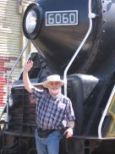

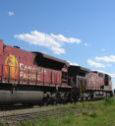




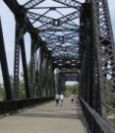
|
The Alberta Central Heritage Model Rail Project:
The History of Rail Transportation in the Municipalities of the Red
Deer Region, particularly within the City of Red Deer and the
communities of Red Deer County.
The Calgary-Edmonton Railway near Red Deer (CP north-south line through Red
Deer)
The Alberta Central Railway (CP line to Rocky Mountain House,
abandoned 1983)
The Canadian Northern Western Railway (CN east-west line to Rocky
Mountain House)
The Grand Trunk Pacific Railway (CN north-south line through
Delburne)
Objectives and Purpose
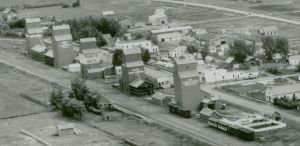 The locations of several towns and the major north-south corridor that
exists today is primarily the result of the building of the four
railways through Central Alberta, and particularly through Red Deer
County and the city of Red Deer. Much of the history of that process is
being lost over time or is being remembered only as isolated displays in
community museums. The locations of several towns and the major north-south corridor that
exists today is primarily the result of the building of the four
railways through Central Alberta, and particularly through Red Deer
County and the city of Red Deer. Much of the history of that process is
being lost over time or is being remembered only as isolated displays in
community museums.
The Central Alberta Historical Model Rail Project is an effort to put
the whole process in perspective on a regional level so that residents,
historians, tourists and rail fans can see how the railway had a
profound effect on the development of Red Deer County and Central
Alberta as we know it
today.
A model rail historical museum is being proposed as an alternative to a
full-scale museum that would normally have actual size displays. The
cost of acquiring, restoring, maintaining and protecting full size
equipment, as well as the cost of maintaining a large museum facility,
would be difficult to sustain without a large financial and volunteer
commitment.
 On the other hand, a heritage centre or interpretive centre using scale
models, would require less space, fewer volunteers and have a special
uniqueness unlike anything else in Canada. On the other hand, a heritage centre or interpretive centre using scale
models, would require less space, fewer volunteers and have a special
uniqueness unlike anything else in Canada.
 A series of miniature interpretive, interactive and operating displays
with moving trains and historically accurate models showing the more
significant eras of rail development in the County and the region will have just as
much meaning, educational and entertainment value and will be much more
flexible and less demanding than a large facility would require. A series of miniature interpretive, interactive and operating displays
with moving trains and historically accurate models showing the more
significant eras of rail development in the County and the region will have just as
much meaning, educational and entertainment value and will be much more
flexible and less demanding than a large facility would require.
The facility could also be complimented by a book and souvenir store,
with the possibility of a snack bar and/or model railroad store as a
means of covering part of the costs of the facility.
Historical Interactive Displays
The most significant eras in the development of communities, changes in
transportation trends and rail technologies affecting the municipalities
of Red Deer County and the region occurred in the following time periods:
 1890-92 -- The building of the Calgary-Edmonton Railway (now
Canadian Pacific) and the location and naming of communities along the
way, including Red Deer, Penhold, Innisfail, Bowden, Olds, Blackfalds,
Lacombe, Ponoka and Wetaskiwin. It marked the end of 'The Crossing'
settlement where Fort Normandeau is today; 1890-92 -- The building of the Calgary-Edmonton Railway (now
Canadian Pacific) and the location and naming of communities along the
way, including Red Deer, Penhold, Innisfail, Bowden, Olds, Blackfalds,
Lacombe, Ponoka and Wetaskiwin. It marked the end of 'The Crossing'
settlement where Fort Normandeau is today;
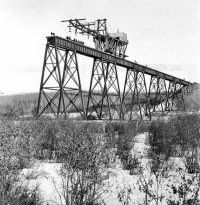 1910-14 -- The 'railway fever' era with plans for railways to run
out of Red Deer in nine directions and included the actual building of
the Alberta Central Railway from Red Deer to Rocky Mountain House (now
abandoned) and the building of the Mintlaw steel trestle bridge across
the Red Deer River (the second longest CP steel bridge in Alberta), the
Canadian Northern Western Railway (now CN) from Stettler through Red
Deer, Rocky Mountain House and on to the Nordegg coal fields, and the
building of the Grand Trunk Pacific Railway (now CN) along the east side
of Red Deer County from Edmonton, through Mirror and Delburne to
Calgary. Red Deer increased its importance as the rail and distribution
hub of Central Alberta. Plans had been established for the Alberta
Central Railway to run east to Delburne and on to Moose Jaw or
Saskatoon, for an Edmonton-Calgary Canadian Northern Western line
through Red Deer and for a Canadian Pacific line to Drumheller; 1910-14 -- The 'railway fever' era with plans for railways to run
out of Red Deer in nine directions and included the actual building of
the Alberta Central Railway from Red Deer to Rocky Mountain House (now
abandoned) and the building of the Mintlaw steel trestle bridge across
the Red Deer River (the second longest CP steel bridge in Alberta), the
Canadian Northern Western Railway (now CN) from Stettler through Red
Deer, Rocky Mountain House and on to the Nordegg coal fields, and the
building of the Grand Trunk Pacific Railway (now CN) along the east side
of Red Deer County from Edmonton, through Mirror and Delburne to
Calgary. Red Deer increased its importance as the rail and distribution
hub of Central Alberta. Plans had been established for the Alberta
Central Railway to run east to Delburne and on to Moose Jaw or
Saskatoon, for an Edmonton-Calgary Canadian Northern Western line
through Red Deer and for a Canadian Pacific line to Drumheller;
 1948-55 -- The steam-to-diesel era and the beginning of the
decline in passenger service as a result of the explosive popularity of
the automobile and the advent of regular air travel. It was during this
period that the Canadian National station closed east of downtown Red
Deer and the Canadian Pacific tore down the roundhouse and other steam
facilities. The beautiful railway garden park became a parking lot. It
was at the end of this period that the special Jubilee 'Chinook' steam
train was replaced by the 'Dayliner'; 1948-55 -- The steam-to-diesel era and the beginning of the
decline in passenger service as a result of the explosive popularity of
the automobile and the advent of regular air travel. It was during this
period that the Canadian National station closed east of downtown Red
Deer and the Canadian Pacific tore down the roundhouse and other steam
facilities. The beautiful railway garden park became a parking lot. It
was at the end of this period that the special Jubilee 'Chinook' steam
train was replaced by the 'Dayliner';
 1983-85 -- Pre-Relocation of Red Deer's rail yards, the
abandonment of the Alberta Central Railway, the final years that grain
elevators dominated the skylines of most towns and the caboose was
becoming a dying breed, a new generation of locomotives permitting much
longer trains were introduced, locomotive shortages saw colourful leased
locomotives from all over North America run through the area, the last
of the Dayliners, the re-introduction of intermodal freight and unit
trains, the realignment of Hwy. 2A south of Red Deer beside the CP line
and the final use of the old CN spur line east into downtown for
storage; 1983-85 -- Pre-Relocation of Red Deer's rail yards, the
abandonment of the Alberta Central Railway, the final years that grain
elevators dominated the skylines of most towns and the caboose was
becoming a dying breed, a new generation of locomotives permitting much
longer trains were introduced, locomotive shortages saw colourful leased
locomotives from all over North America run through the area, the last
of the Dayliners, the re-introduction of intermodal freight and unit
trains, the realignment of Hwy. 2A south of Red Deer beside the CP line
and the final use of the old CN spur line east into downtown for
storage;
 the near future (2010-20) -- The renewal of passenger rail
service in the form of light rail, high speed rail and tourist and
'green'-oriented tramways and new industrial development requiring rail
access (eg. proposed biofuel plant north of Innisfail). the near future (2010-20) -- The renewal of passenger rail
service in the form of light rail, high speed rail and tourist and
'green'-oriented tramways and new industrial development requiring rail
access (eg. proposed biofuel plant north of Innisfail).
Much significant rail infrastructure was built, modified, abandoned or
destroyed over the past 115 years that could be preserved in model form
and various types of rail equipment that was used over the years can be
visually highlighted in operational displays that would otherwise be
impossible, or at least impractical, to duplicate in any other form.
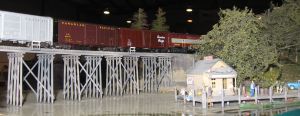 The
project could become a world-class facility if done to a high standard.
There are very few similar type projects in North America and really
none in Canada that would meet museum standard. The
project could become a world-class facility if done to a high standard.
There are very few similar type projects in North America and really
none in Canada that would meet museum standard.
The largest facility of its kind is in San Diego, California at 27,000
sq. ft. with 5 operating layouts in various model scales. The few other
similar facilities are in the 5,000-10,000 sq. ft. range.
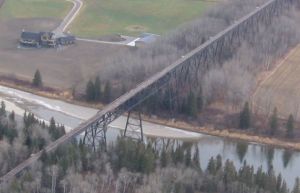 The
project could be built in either HO scale (1:87) or N scale (1:160).
Although HO is more popular among modellers, N scale provides the
benefit of much more railroad in much less space. Even in N scale, if
the former Red Deer CPR yards were recreated exactly, it would be 24'
long without inclusion of the river bridge and the Mintlaw steel trestle
over the Red Deer River would be 13' long. Some selective compression
would still likely be necessary to model any extensive rail facility. The
project could be built in either HO scale (1:87) or N scale (1:160).
Although HO is more popular among modellers, N scale provides the
benefit of much more railroad in much less space. Even in N scale, if
the former Red Deer CPR yards were recreated exactly, it would be 24'
long without inclusion of the river bridge and the Mintlaw steel trestle
over the Red Deer River would be 13' long. Some selective compression
would still likely be necessary to model any extensive rail facility.
A
representative series of historical layouts could be done in as little
as 1,500 sq. ft. but a minimum of 3,500 sq. ft. would be necessary to
make it world-class and a viable tourist attraction. To achieve maximum
visitor attraction, the facility should be located near the existing
Canadian Pacific north-south main line, near significant sites of
historic value with easy access by road and trail.
 Such an interpretive centre could be located in Penhold, Innisfail,
Bowden, Springbrook or the future Liberty Crossing near the Tuttle
junction to meet the preferred criteria but could also be located in
downtown Red Deer, Sylvan Lake, Benalto or near the Mintlaw bridge along
the C & E Trail and still have both historic and tourist value. Such an interpretive centre could be located in Penhold, Innisfail,
Bowden, Springbrook or the future Liberty Crossing near the Tuttle
junction to meet the preferred criteria but could also be located in
downtown Red Deer, Sylvan Lake, Benalto or near the Mintlaw bridge along
the C & E Trail and still have both historic and tourist value.
Complimenting the operating model railroad displays would be dioramas,
local railroad memorabilia, historic photographs, videos and other
interpretive displays. Other amenities could include a workshop for
hands-on seminars on various aspects of model building and heritage
preservation (especially for youth), a snack bar, bookstore, souvenir
booth and model supply store.
The Alberta Central Heritage Model Rail Project has now been
incorporated into a much larger and bolder concept for a major tourist
and community attractor in Red Deer and area called
the Forth
Junction Project.
Railway Heritage Preservation
in Central Alberta
'Moving People by Rail' Themed
Community Proposal
Historic Rail Background
for 'Moving People by Rail'

|
|
|